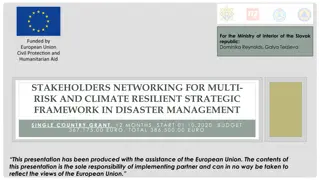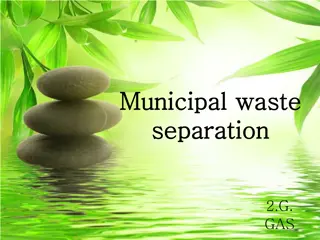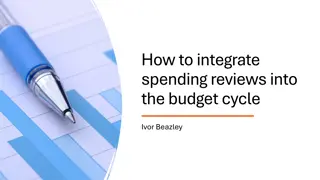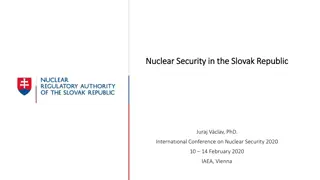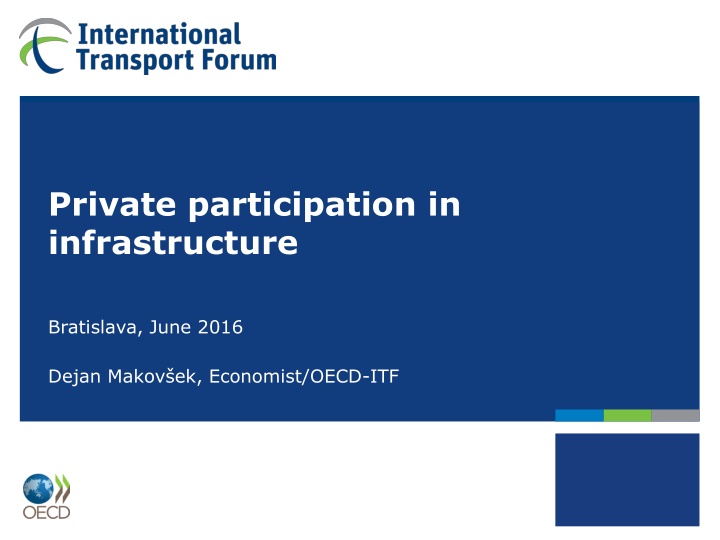
Private Participation in Infrastructure and PPP Models
Discover the reasons behind Private Sector Participation in Infrastructure (PSPI), the challenges in traditional public models, forms of PPPs, and the economic vehicles involved. Learn about the PPP (Project Finance) Model and how competition determines the ultimate cost of service. Dive into the complexities and benefits of Private Sector Involvement in Infrastructure projects.
Download Presentation

Please find below an Image/Link to download the presentation.
The content on the website is provided AS IS for your information and personal use only. It may not be sold, licensed, or shared on other websites without obtaining consent from the author. If you encounter any issues during the download, it is possible that the publisher has removed the file from their server.
You are allowed to download the files provided on this website for personal or commercial use, subject to the condition that they are used lawfully. All files are the property of their respective owners.
The content on the website is provided AS IS for your information and personal use only. It may not be sold, licensed, or shared on other websites without obtaining consent from the author.
E N D
Presentation Transcript
Private participation in infrastructure Bratislava, June 2016 Dejan Makov ek, Economist/OECD-ITF
There are plenty of reasons to consider PSPI The main reasons come from the mitigation of the failures of traditional (public) model: prevention of time inconsistent behaviour of governments (budgeting/hidden expropriation) There is no national balance sheets, no current cost accounting => saving on infrastructure maintenance is never immediately visible To counter the above infrastructure managers pursue cash-flow protection strategies (excess employment, union power ), which hurts operational efficiency Limited incentives for efficient delivery of infrastructure Public project managers need to follow multiple objectives (union pressures; tendency to cut as many ribbons as possible, also leads to ex-post scope changes and cost overruns) difficult to ensure accountability (multi-year construction - in a couple years a project will be somebody else's problem) In summary these are public governance challenges!
and there are many forms of it Forms of PSP BOT and variants Service contract (outsourcing) Manageme nt contract Lease/ Affermage Concession Divestitures (privatisation) Characteristics What PPPs encompass Scope (discrete piece or network) Discrete existing assets and network Normally discrete existing assets Discrete existing assets port terminal) and networks (e.g. water) Discrete new assets or refurbishment Existing networks and normally existing point infrastructure (e.g. sea/ airports) 25-30 years Existing network and point infrastructure (e.g. sea/ airports) (e.g. Contract duration Commercial risk for the private party Money at risk ex ante Provider of service or management 1-3 years 2-5 years 10-20 years 25-30 years Perpetual/ subject to licence Both options (yes or no) None None Yes Both options (yes or no) Both options (yes or no) No No No Yes Yes Yes Private Private Private Private Private Private
4 The two main vehicles of PSPI Economic regulator Bidder 1 Monitoring Bidder 2 Bidder 3 Infrastructure manager Carrot Stick [regulatory contract] PPP contract Duty to finance Budgeting, Time inconsistency
The PPP (Project Finance) Model The ultimate cost of service gets determined through competition! Owner (developer) SPV Equity investor Availabil. payment /user charge Equity C L I E N T (Potential) incentives of common ownership Construction risk Construction contractor Debt Lender-comfort measures Service Lenders
The RAB Model (I) The RAB by itself is a set of principles, which require that the assets in the RAB are maintained in line with financial capital maintenance. Normally used for existing assets, but can be extended to deliver new assets as well. It s transparency and approach prevent hidden expropriation. For the investor the regulated revenue must recover: depreciation (investments to preserve the value of the RAB), new investments into new infrastructure (expansion of the RAB), operating costs, financing cost (the cost of equity and debt, which involve an appropriate reward or return). The recovery of operating cost (and thus also the returns) is put at risk subject to efficiency targets set by the regulator.
The RAB Model (II) The cost of service gets determined by the regulator! Dedicated Source (if necessary) Economic regulator (independent agency) Budget revenue Duty to fund infra manager (by tariff setting) License fee (Fund the regulator) Strategic policy development Payment Infrastructure Manager (of a network) Users (and/or state) State Services Regulatory framework Incentives for efficient operation Monitoring Legal duty of financing activities ... Budgetary expenditure
8 Value for Money Dimensions Competition = 1st best Regulation = 2st best Theoretical expectations VfM dimensions Traditional PPP RAB Infrastructure delivery Infrastructure operation (relative) Cost of financing x x Low High Medium
What is the comparative performance of PPPs and the RAB model There is no comprehensive comparative performance research of PPPs vs other forms of infrastructure provision and management available!
10 Value for Money Dimensions in Infrastructure Productive efficiency evidence exists, but it is not clear, whether the price is fair for a given service level Empirical evidence VfM dimensions Infrastructure delivery Infrastructure operation (relative) Cost of financing Traditional PPP RAB x ? ? x ? Low High Medium VfM to society n/a ? ?
11 PPP challenges Three prerequisites to achieve VfM in competition for the contract Information on risk/returns Inefficient risk pricing at multiple levels Competition Credible commitment to the contract. (massive renegotiation problems in many geographies)
What are the challenges of RAB model in developed countries The operational efficiency is well established in the literature, returns/cost of financing are low/subject to regulation. The key challenge appears to be capital expenditure efficiency: For the regulator the capex efficiency is much more difficult to determine and takes much more time to unfold (whether it was efficient or not + narrative/benchmarking issues) The biggest challenge to the model (assuming government commitment is credible) are the perceived incentives of private operators to inflate their regulated asset base, on which their return is calculated. The manifestations of these incentives are known as capex bias (preference of capex solutions vs opex ones) and the AJW effect (e.g. goldplatting). But 30 years of empirical research yielded little trace of the AJW effect (Law 2014). It s not clear why (these incentives are offset by other ones or there are not that many opportunities to prefer capex solutions over opex; measurement issues).
To summarize The emerging picture is: PPPs Regulated privatization Returns Returns Assets Assets
14 Value for Money in what circumstances Regulation = 2st best Competition = 1st best Current evidence empirical Sector dependant? VfM Traditional PPP RAB Network infrastructure (natural monopoly) Node infrastructure (competitive market) (?) ??? x x ? n/a
Caveats The findings in this study are mainly based on research studies, conducted in developed economies. There are obvious complexities across sectors and countries at different stages of development that warrant care in their interpretation. More empirical evidence is needed to help understand PPP outcomes better. The capex bias does not appear to be a serious issue in the RAB model, but more research is needed, as it is not clear why. In cases, where public governance is challenged, PPPs can bring an improvement to the traditional approach (e.g. breaking union capture, potentially reduce pillaging of tolls). When public sentiment does not favour privatisation or a concession of the network, it may be politically more feasible to execute a project finance PPP. A PPP can be deployed comparably fast, whereas the setup of an economic regulator and the build-up of its capacity takes more time. Indeed it is preferred that the RAB is first applied on a public entity and then later privatized/concessioned. Both PPPs and RABs cannot in themselves resolve the issue of governments ability to commit or corruption issues a regulator, that is not independent and well-resourced or a poorly executed PPP will both deliver poor Value for Money. In networks a change in infrastructure policy will be easier accommodated by the RAB, whereas many affected PPPs will require a lot of renegotiations.
Thank you! dejan.makovsek@itf-oecd.org
Can private finance fill the gap? (I) Infrastructure is funded either by all the tax payers (direct government provision, shadow tolls) or by the users (which is a select group of taxpayers) Both options theoretically exist in traditional public provision or a PPP (in a PPP the taxpayers pay, when an availability based model is in place) So if there is somebody who is willing to pay for the infrastructure, why would it matter, where we borrow the money? Why would changing the source of financing solve a funding problem?
Can private finance fill the gap? (II) A transport analogy to infrastructure financing models (THE STEERING/Driver) The National Transport Plan (THE FUEL) The financing mix (THE DRIVER S WALLET) Affordability (public finance) TRANSPORT INFRA POLICY (private finance) (THE ENGINE) The infrastructure governance model



